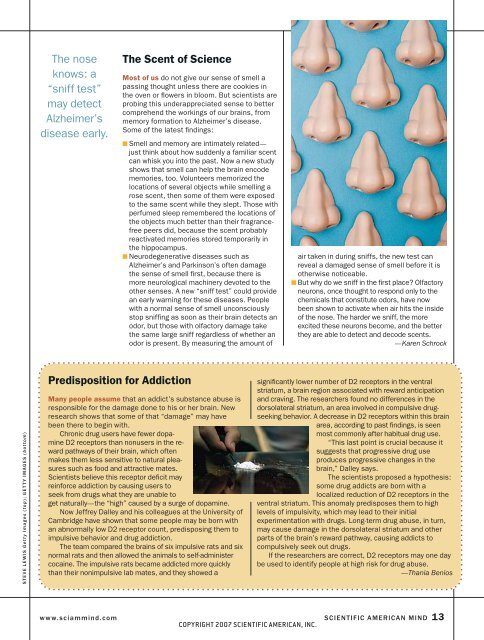Scientific American Mind-June/July 2007
Scientific American Mind-June/July 2007
Scientific American Mind-June/July 2007
Create successful ePaper yourself
Turn your PDF publications into a flip-book with our unique Google optimized e-Paper software.
STEVE LEWIS Getty Images (top); GETTY IMAGES (bottom)<br />
The nose<br />
knows: a<br />
“sniff test”<br />
may detect<br />
Alzheimer’s<br />
disease early.<br />
The Scent of Science<br />
Predisposition for Addiction<br />
Most of us do not give our sense of smell a<br />
passing thought unless there are cookies in<br />
the oven or fl owers in bloom. But scientists are<br />
probing this underappreciated sense to better<br />
comprehend the workings of our brains, from<br />
memory formation to Alzheimer’s disease.<br />
Some of the latest fi ndings:<br />
■ Smell and memory are intimately related—<br />
just think about how suddenly a familiar scent<br />
can whisk you into the past. Now a new study<br />
shows that smell can help the brain encode<br />
memories, too. Volunteers memorized the<br />
locations of several objects while smelling a<br />
rose scent, then some of them were exposed<br />
to the same scent while they slept. Those with<br />
perfumed sleep remembered the locations of<br />
the objects much better than their fragrancefree<br />
peers did, because the scent probably<br />
reactivated memories stored temporarily in<br />
the hippocampus.<br />
■ Neurodegenerative diseases such as<br />
Alzheimer’s and Parkinson’s often damage<br />
the sense of smell fi rst, because there is<br />
more neurological machinery devoted to the<br />
other senses. A new “sniff test” could provide<br />
an early warning for these diseases. People<br />
with a normal sense of smell unconsciously<br />
stop sniff ing as soon as their brain detects an<br />
odor, but those with olfactory damage take<br />
the same large sniff regardless of whether an<br />
odor is present. By measuring the amount of<br />
Many people assume that an addict’s substance abuse is<br />
responsible for the damage done to his or her brain. New<br />
research shows that some of that “damage” may have<br />
been there to begin with.<br />
Chronic drug users have fewer dopamine<br />
D2 receptors than nonusers in the reward<br />
pathways of their brain, which often<br />
makes them less sensitive to natural pleasures<br />
such as food and attractive mates.<br />
Scientists believe this receptor defi cit may<br />
reinforce addiction by causing users to<br />
seek from drugs what they are unable to<br />
get naturally—the “high” caused by a surge of dopamine.<br />
Now Jeffrey Dalley and his colleagues at the University of<br />
Cambridge have shown that some people may be born with<br />
an abnormally low D2 receptor count, predisposing them to<br />
impulsive behavior and drug addiction.<br />
The team compared the brains of six impulsive rats and six<br />
normal rats and then allowed the animals to self-administer<br />
cocaine. The impulsive rats became addicted more quickly<br />
than their nonimpulsive lab mates, and they showed a<br />
air taken in during sniffs, the new test can<br />
reveal a damaged sense of smell before it is<br />
otherwise noticeable.<br />
■ But why do we sniff in the fi rst place? Olfactory<br />
neurons, once thought to respond only to the<br />
chemicals that constitute odors, have now<br />
been shown to activate when air hits the inside<br />
of the nose. The harder we sniff, the more<br />
excited these neurons become, and the better<br />
they are able to detect and decode scents.<br />
—Karen Schrock<br />
signifi cantly lower number of D2 receptors in the ventral<br />
striatum, a brain region associated with reward anticipation<br />
and craving. The researchers found no differences in the<br />
dorsolateral striatum, an area involved in compulsive drugseeking<br />
behavior. A decrease in D2 receptors within this brain<br />
area, according to past fi ndings, is seen<br />
most commonly after habitual drug use.<br />
“This last point is crucial because it<br />
suggests that progressive drug use<br />
produces progressive changes in the<br />
brain,” Dalley says.<br />
The scientists proposed a hypothesis:<br />
some drug addicts are born with a<br />
localized reduction of D2 receptors in the<br />
ventral striatum. This anomaly predisposes them to high<br />
levels of impulsivity, which may lead to their initial<br />
experimentation with drugs. Long-term drug abuse, in turn,<br />
may cause damage in the dorsolateral striatum and other<br />
parts of the brain’s reward pathway, causing addicts to<br />
compulsively seek out drugs.<br />
If the researchers are correct, D2 receptors may one day<br />
be used to identify people at high risk for drug abuse.<br />
—Thania Benios<br />
www.sciammind.com SCIENTIFIC AMERICAN MIND 13<br />
COPYRIGHT <strong>2007</strong> SCIENTIFIC AMERICAN, INC.

















